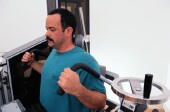
THURSDAY, May 2 (HealthDay News) — Most Americans are falling short when it comes to exercise, a new government report shows.
Overall, only 20 percent of U.S. adults get the recommended amounts of both of aerobic and muscle-strengthening exercise, according to the U.S. Centers for Disease Control and Prevention. The news was less disappointing for aerobic exercise, with 51.6 percent of adults getting the recommended amount, than it was for muscle-strengthening activities, with only 29.3 percent getting the recommended amount.
The overall exercise rates also varied widely by state, ranging from 13 percent in Tennessee and West Virginia to 27 percent in Colorado.
The researchers put a positive spin on the results.
“While only about 30 percent of adults meet the muscle-strengthening guidelines, we find it very encouraging that half of U.S. adults are meeting the aerobic guidelines,” said report author Carmen Harris, a CDC epidemiologist.
The report was published in the May 3 issue of the Morbidity and Mortality Weekly Report, a CDC publication.
One expert also thinks the findings are good news.
“It is great that more people are participating in regular exercise,” said exercise physiologist Samantha Heller.
“Exercise not only helps with weight management, it helps reduce anxiety and depression; boosts energy, immunity and brain power; and significantly lowers the risk for chronic diseases such as cancer, diabetes and cardiovascular disease,” she said.
According to the Physical Activity Guidelines for Americans, adults should get at least two and a half hours a week of moderate-intensity aerobic activity such as walking, or an hour and 15 minutes a week of vigorous-intensity aerobic activity, such as jogging.
In addition, adults should do muscle-strengthening activities, such as push-ups, sit-ups or activities using resistance bands or weights. These exercises should be done two or more days a week and work all major muscle groups, the guidelines suggested.
The highest proportion of adults meeting those guidelines were in the West (24 percent) and the Northeast (21 percent).
Women, Hispanics and older and obese adults were less likely to meet the guidelines, they added.
“Exercise is essential for the aging population to maintain their independence and quality of life,” Heller said. “The results of this report indicate that certain states and populations need to be targeted with programs that encourage regular physical activity while taking into account their cultural and economic needs. Local YMCAs, senior centers and other organizations often offer low-cost or free fitness classes.”
“Simple steps to start moving include: enlisting a friend or family member to join you; taking a walk every evening after dinner; getting up and marching in place at every TV commercial; limiting TV and computer time; [and] scheduling your time to exercise in your daily calendar,” Heller said.
These data are based on information from the Behavioral Risk Factor Surveillance System, which is a yearly phone survey of adults aged 18 and over.
More information
For more recommendations on physical activity, visit the U.S. Department of Health and Human Services.

